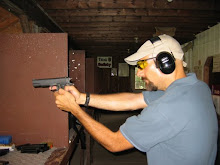Method to Track Firearm Use Is Stalled by Foes
Identifying the firearm used in a crime is one of the biggest challenges for criminal investigators. But what if a shell casing picked up at a murder scene could immediately be tracked to the gun that fired it?A technique that uses laser technology and stamps a numeric code on shell casings can do just that. But the technology, called microstamping, has been swept up in the larger national debate over gun laws and Second Amendment rights, and efforts to require gun makers to use it have stalled across the nation.
And, the NYT handily neglects to mention, that it doesn't work, is easily defeated, and would yield tracking of incredibly dubious nature. They're talking about altering the firing pin of a semi-automatic pistol so that it leaves an imprint on the primer unique to that exact handgun. It sounds like a slam-dunk, right? You would be able to instantly connect a crime scene firearm with the casings at the scene.
But let's look at just some of the problems that microstamping faces:
1. It assumes that the face of the firing pin - the part of the gun that comes into contact with the primer, igniting the round and launching the projectile - will be unchanged over the life of the firearm. Most experts agree that the firing pin stamp would be rapidly be rendered unreadable, often in as few as a couple hundred rounds.
2. It assumes that a criminal would not take a file to the firing pin, replace the firing pin with a non-marked pin, or otherwise chance the imprint.
3. It assumes that the gun used is registered to the criminal using it.
4. It assumes that the brass will be left behind - won't happen with a revolver - and that no one will ever toss in extra brass as a decoy.
5. Even if all of the above come together, there's still the question of whether the firearm can be linked to the actual shooting - now they have to prove that the bullets in the body match the casings found at the scene. They're introducing yet another layer of complexity in the prosecution - they have to prove that the casings match the gun, the gun matches the shooter, and now that the bullets match the casings.
Oh, and pegging 100% on the irony meter is that the NYT article quotes the Baltimore Police Commissioner. Not only is Baltimore one of the most dangerous cities, in a state that is *extremely* hard to get a legal CCW permit in, but Maryland itself scrapped the ballistic fingerprinting program that was in place that yielded exactly zero matches in the decade it was in place. DO IT AGAIN ONLY HARDER - that's the mantra of gun control. Ballistic fingerprinting was cumbersome, added cost unnecessarily, and solved zero crimes? Let's mandate a program that's harder to implement, will add costs even more, and also solve zero crimes.
We all know the real reason driving these cockamamie ideas - to drive up the cost of firearms to the point where most people can't afford them. Through the magic of the 1934 National Firearms Act and the 1986 Hughes Amendment, most people under the age of 40 have little to no experience with fully automatic weapons. With the price of even entry level machine guns being more than most folks spend on a decent used car, only the very wealthy can afford to indulge - so fewer and fewer people are exposed to them.
Well, why not extend that to all semi-automatic weapons? Drive the cost through the roof by adding in microstamping firing pins, integral biometric locks, and 50 other "new" safety measures, none of which will do a damned thing to stop or solve crimes. Each one will add another $100 onto the price a new gun, you bet, as well as creating a scheme whereby old, non-conforming guns will have to be brought into compliance or destroyed. When even a Hi-Point costs $2,500, who will own firearms?
And that's exactly their goal, and they know it.
That is all.



1 comment:
I should add microstamping service to my repertoire.
While it can work in limited circumstances, there are some serious technical and safery issues with it. Adding texture to the firing pin increases the risk of a primer puncture - venting 15,000 - 50,000 PSI into the gun. That little jet of plasma will also demolish the tip of the firing pin...
Also, NFA34 - that law as drafted covered handguns as well. Later revised only to cover AOWs and not all handguns. Now picture a NFA tax, CELO signature, prints required, and 4-7 month approval time for a transfer on a handgun. It's a perfect way to keep anything from changing hands.
Post a Comment